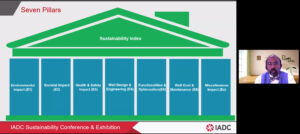Sustainability index system incorporates AI, uncertainty modeling throughout the well lifecycle
By Stephen Whitfield, Associate Editor
While the digital transformation has led to major advancements in the oil and gas industry, so far technologies such as cloud computing and digital twins have not been heavily leveraged to progress ESG. One opportunity, according to Robello Samuel, Chief Technical Advisor and Technology Fellow at Halliburton, is to apply digital technologies to quantify the sustainability of a well, in real time, starting from when it is designed through to its drilling and completion.

Speaking at the 2021 IADC Sustainability Conference on 9 February, Dr Samuel presented the concept for an artificial intelligence (AI)-based methodology – what he called a “sustainability index” – to estimate and display sustainability in well design and operation. The index is a weighted multidimensional model grounded in engineering principles that enables optimal decision making with regards to sustainability. Dr Samuel described the methodology as a collection of well-level “report cards” that can be used to measure key performance indicators (KPIs).
“We’re implementing environmental protections, but we need a scorecard, or some kind of indicator that we can use as an intrinsic reference, so that we can actually quantify the progress that we’re making and bring ourselves into the next level of good corporate citizenship,” Dr Samuel said.
His proposed sustainability index, Dr Samuel said, would be the first in the oil and gas industry to introduce a three-way coupling system incorporating physics and data science with an uncertainty model to provide comprehensive analysis of the sustainability of various activities during the lifecycle of a well. He described the model as an expandable system that users can customize to suit their needs.
The index uses seven modules, which Dr Samuel referred to as the “seven pillars,” to measure the impact of an activity on sustainability:
- environmental impact, primarily involving carbon emissions;
- societal impact;
- health and safety impact;
- well design and engineering;
- functionalities and optimization;
- well cost and maintenance; and
- miscellaneous impacts on sustainability.
The use of physics- and data-based models provides a more comprehensive insight into a physical system; the mathematical framework used to describe the system in a physics-based model can be used to teach the data-driven model how to use real-time data to predict the system’s behavior. Uncertainty in each model has been extensively studied and can be taken into account during the design and operation of the system.
Traditionally, sustainability indices have utilized a variety of methods to calculate the values of an indicator, such as a simple scoring method, where people assign numerical values to specific actions, or the fuzzy logic approach, which allows for multiple values to be processed through the same variable. But for a process with as much complexity and uncertainty as the design and drilling of a well, Dr Samuel believes a simple scoring method is insufficient.
“If you look at a simple system where you assign values and weights, that may be easy to do with a model that has 10 variables or less, but we are dealing with a lot of variables when it comes to the well. If you take surveys, downhole tools and other things, you see a lot of components going into the operation of a well. We need to go into another option.”
The proposed model uses a neuro-fuzzy system – a combination of fuzzy logic and an artificial neural network – to estimate sustainability values. Such a system effectively emulates the operation of the human brain, with the neural network concentrating on basic functions and the fuzzy logic system emulating symbolic reasoning. This system analyzes the data outputs generated from the coupled models to generate scores for any given activity over the lifetime of a well, with the seven “pillars” serving as the basic criteria for users to determine what they may need to change.
The full-length version of this article, with details about how this system operators, will be published in the March/April 2021 issue of Drilling Contractor magazine.




